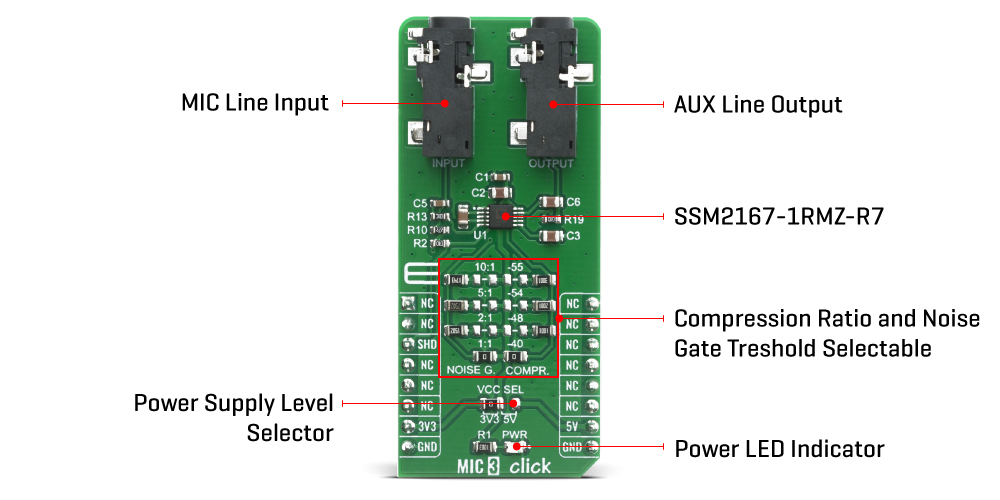OFF
GO LOCAL
| Company | Stock | Price |
|---|---|---|

MIKROE-4136
21 g
Status:
The MIC 3 Click is a Click board™ that features the SSM2167-1RMZ-R7, a Microphone Preamplifier, from Analog Device. This Click board™ is a low voltage Microphone preamplifier with Variable compression and noise gating. The MIC 3 Click is a very easy solution to work with it, which makes it an ideal solution for using it in desktop, portable or palmtop computers, telephone conferencing, communication headsets, two-way communication, surveillance system where the microphone is needed, stethoscope, karaoke and DJ mixers.
The MIC 3 Click is supported by a mikroSDK compliant library, which includes functions that simplify software development. This Click board™ comes as a fully tested product, ready to be used on a system equipped with the mikroBUS™ socket.
This product is no longer in stock
Availability date:
OFF
| Company | Stock | Price |
|---|---|---|

The MIC 3 Click based on the SSM2167-1RMZ-R7 from Analog Devices is a complete and flexible solution for conditioning microphone inputs in personal electronics and computer audio systems. The Click board™ is also excellent for improving vocal clarity in communications and public address systems. A low noise voltage-controlled amplifier (VCA) provides a gain that is dynamically adjusted by a control loop to maintain a set compression characteristic. The MIC 3 Click provides two operation settings, these settings are selectable with NOISE G. COMPR. jumpers.
The MIC 3 Click provides four different preset values of the noise gate threshold. Experiment with these values by varying the gate. The noise gate threshold is a programmable point using an external resistor. The downward expansion threshold may be set between −40 dBV and −55 dBV, as shown in Table.
| Noise Gate (dBV) | Value of RGATE |
|---|---|
| -40 | 0 Ω |
| -48 | 1 Ω |
| -54 | 2 Ω |
| -55 | 3 Ω |

The Click board™ provides four different preset values of the compression ratio. Changing the scaling of the control signal fed to the VCA causes a change in the circuit compression ratio.Lowering RCOMP gives smaller compression ratios as indicated in Table. Automatic Gain Control (AGC) performance is achieved with compression ratios between 2:1 and 10:1, and is dependent on the application. Shorting RCOMP disables the AGC function, setting the compression equal to 1:1.
| Compression Ratio | Value of RCOMP |
|---|---|
| 1:1 | 0 Ω |
| 2:1 | 15 Ω |
| 5:1 | 75 Ω |
| 10:1 | 174 Ω |
The MIC 3 Click is designed to work with either 3.3V or 5V power supply. It communicates with the target MCU over GPIO pin on the mikroBUS™. The supply current of the SSM2167 can be reduced to under 10 μA by applying an active low.
Type
Microphone
Applications
Karaoke and DJ mixers,Desktop, portable, or palmtop computers,Telephone conferencing.
On-board modules
SSM2167-1RMZ-R7, Low Voltage Microphone Preamplifier from Analog Device.
Key Features
Adjustable noise gate threshold,Adjustable compression ratio.
Interface
GPIO
Feature
No ClickID
Compatibility
mikroBUS™
Click board size
L (57.15 x 25.4 mm)
Input Voltage
3.3V or 5V
This table shows how the pinout on MIC 3 Click corresponds to the pinout on the mikroBUS™ socket (the latter shown in the two middle columns).
| Label | Name | Default | Description |
|---|---|---|---|
| LD1 | PWR | - | Power LED Indicator |
| - | NOISE G. COMPR | 1:1, -40 | Select noise gate threshold and compression ratio. |
We provide a library for the MIC 3 Click on our LibStock page, as well as a demo application (example), developed using MikroElektronika compilers. The demo can run on all the main MikroElektronika development boards.
Library Description
Library provides function for setting state of the pin, and function for GPIO mapping.
Key functions:
void mic3_set_shd_pin ( uint8_t state ) - Function for setting shd pin stateExamples description
The application is composed of three sections :
void application_init ( )
{
mikrobus_logWrite( " ***** APP INIT ***** ", _LOG_LINE );
mic3_gpio_driver_init( (mic3_obj_t)&_MIKROBUS1_GPIO );
mic3_set_shd_pin( MIC3_PIN_STATE_HIGH );
mikrobus_logWrite( " ***** APP TASK ***** ", _LOG_LINE );
mikrobus_logWrite( " - Microphone is turned on - ", _LOG_LINE );
}
The full application code, and ready to use projects can be found on our LibStock page.
Other Mikroe Libraries used in the example:
Additional notes and informations
Depending on the development board you are using, you may need USB UART click, USB UART 2 click or RS232 click to connect to your PC, for development systems with no UART to USB interface available on the board. The terminal available in all MikroElektronika compilers, or any other terminal application of your choice, can be used to read the message.
This Click board™ is supported with mikroSDK - MikroElektronika Software Development Kit. To ensure proper operation of mikroSDK compliant Click board™ demo applications, mikroSDK should be downloaded from the LibStock and installed for the compiler you are using.
For more information about mikroSDK, visit the official page.
NOTE: Please be advised that any peripheral devices or accessories shown connected to the Click board™ are not included in the package. Check their availability in our shop or in the YMAN section below.